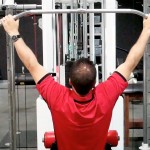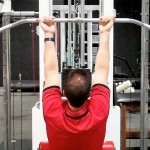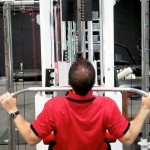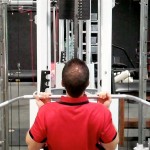Brian Schiff’s Blog
Injury Prevention, Sports Rehab & Performance Training Expert
High school baseball season is upon us. My son is a high school junior and recently verbally committed to pitch for a Division 1 school. He has worked hard to earn that offer, but the part most people do not see is the arm care and recovery work we do for him behind the scenes. Below is a recent picture of him in action.

I see lots of baseball players in my clinic ranging from 10 year olds to my MLB guys. One of the biggest issues I confront in my players (more commonly pitchers and catchers) is a condition known as internal impingement. While not the same thing as subacromial impingement, it still can impact the rotator cuff. Essentially, there is friction that causes irritation and in some cases injury to the rotator cuff and/or labrum. This usually manifests as pain in late cocking and the inability to throw hard without pain. Pitchers report decreased velocity and catchers struggle to thrown down to second with their their normal ease.
One of the most common issues leading to this is a loss of total shoulder motion on the throwing arm. Most notably, some players display significantly less internal rotation (IR) range of motion. Some loss of internal rotation is normal and expected over time provided they gain enough external rotation (ER) on the throwing side to counterbalance the asymmetry. Often, too much throwing early in the season or a big jump in pitch count/intensity/volume coupled with the ROM loss causes pain. This can occur suddenly or gradually build up over a few outings or games.
Baseball pitchers who fail nonoperative care for SLAP injuries will undergo a repair if they wish to continue throwing. The injury may occur at ball release as the biceps contracts to resist glenohumeral joint distraction and decelerate elbow extension. The other thought is that injury occurs in late cocking as the result of a “peel back” mechanism when the abducted shoulder externally rotates. Previous research by Shepard et al. published in American Journal of Sports Medicine (AJSM) measured in vitro strength of the biceps-labral complex during the peel back and distal force and concluded that repetitive force in both scenarios likely causes SLAP lesions.

“Baseball pitching motion 2004“. Licensed under CC BY-SA 3.0 via Wikimedia Commons.
One of the concerns for pitchers after surgery is regaining full shoulder external rotation and horizontal abduction. If too much tension is placed on the glenohumeral ligaments during surgery, regaining motion can be tough. Ironically, external rotation is limited in the early phase of rehab to protect the labral repair which may impair throwing mechanics later on. Appropriate rehab and progression is paramount for long term success.
Laughlin et al. at the ASMI sought out to explore in a labaratory if there are differences in pitchers who underwent a SLAP repair compared to those in age controlled groups without injury. In a paper published in the Dec. 2014 AJSM, the researchers hypothesized that the SLAP group would exhibit compromised shoulder range of motion and internal range of motion torque during pitching. Of 634 pitchers (collegiate and professional) tested at ASMI from 2000 – 2014, 13 in this group were included in the SLAP group as they had undergone a SLAP repair at least 1 year before their biomechanical testing.
One of the most common issues I see in the clinic with active exercise enthusiasts between the age of 20 and 55 is shoulder pain. Weightlifting has been popular for ages, but Crossfit is all the rage these days. Both disciplines involve overhead lifts. The key thing to remember when performing overhead repetitive lifts is how load and stress not only affects strength and power, but how it impacts the joint itself.
Pull-ups and pull-downs are staples for most clients I see. As a therapist and strength coach, I am always thinking and analyzing how variables such as grip, grip width, arm position, scapular activation, trunk angles etc influence exercise and how force is absorbed by the body. One such exercise I have spent time studying and tweaking is the lat pull-down.
Consider for a moment how width and grip impacts the relative abduction and horizontal external rotation in the shoulder at the top and bottom of the movement in the pictures below (start and finish positions are vertically oriented):
It should be common knowledge for most, but I will state it for the record anyway – you should NEVER do behind the neck pull-downs. Beyond the horrible neck position, this places the shoulder in a dangerous position for impingement and excessively stresses the anterior shoulder capsule. A wider grip (be it with pull-ups, pull downs, push-ups) will always transfer more stress to the shoulder joint because you have a longer lever and greater abduction and horizontal external rotation.
So, what bearing does this have in relation to the rotator cuff and SLAP injuries? For more information and details on the application of the grip choice, click here to read the full column I did for PFP Magazine this month. Stay tuned for my next post (a follow-up to this one) one of my Crossfit patients who now only has pain with overhead squats and how my differential diagnosis and rehab has led me to conclude what is wrong with his shoulder. Keep in mind we must learn to train smarter so we can train harder and longer without pain and injury. Biomechanics and understanding your own body really does matter.
By far the most comments on my blog and emails that flood my inbox these days have to do with SLAP tears. I must admit that outside of ACL tears and rotator cuff issues, I find myself increasingly drawn to studying and researching this issue. It definitely is a source of great pain for many and an issue that medical professionals are challenged by today.
In my personal clinical experience, I see good, bad and in between outcomes. Through email and my blog I tend to read more on the not so good side from people who are seeking my expertise in how to resolve their issues. When I speak to surgeons, I find they are often hesitant to commit to a set algorithm of treatment, and they are not 100% sure what the right answer is in addressing these injuries as a whole.
If you read the literature, the success in terms of patient satisfaction and return to premorbid activity levels is not going to make you rush down to the operating room and opt for an arthroscopic repair if you are an overhead athlete (especially baseball players). However, other studies have presented more favorable data ranging from 63%-75% good-excellent satisfaction in other overhead athletes who have had the procedure done.
If you are unfamiliar with SLAP tears, I suggest reading my original post on them (click here). In today’s post, I wanted to present a quick recap on Type II SLAP tears and some new published research on the results of revision procedures where the primary repair failed.
Below are two images of a type II tear (MRI and operative view from the scope)
Keep in mind a type II tear means the biceps anchor/superior labrum has pulled away from the glenoid with resulting instability of the complex. This is the most common type of tear seen among injured people. In a study from the Kerlan-Jobe Orthopaedic Clinic in LA in the latest American Journal of Sports Medicine (June 2011 – click here for the abstract), they discussed a chart review of from 2003-2009 looking at patients who had undergone revision type II SLAP repairs.
I probably get more emails about shoulder problems than anything else. Most of the emails center on rotator cuff and SLAP tears, as well as whether or not to have surgery.
Let me be clear – I am not going to tell you TO or NOT TO have surgery in this post. That is for you and your MD to decide. However, I will give you my thoughts on key considerations with respect to this major decision.
Below are some major considerations to take into account if you are facing this dilemma.
Indications for having surgery:
- Unremitting pain (especially at night)
- Loss of daily function (dressing, bathing, self care activities)
- Marked loss of strength
- Bony impingement with failed rehab
- Moderate to massive tears with active jobs, healthy and < 50 y/0
- Isolated partial and full thickness tears with high probability of operative success after failed rehab
Now, some contraindications for surgery:
- Weakened tissue (including too much tissue retraction or shortening)
- Multiple tears in older population
- Failed previous rotator cuff repair
- High risk patients (includes those with cardiovascular and other medical issues)
- No rehab trial to date
- Partial or full thickness tears with good range of motion, negligible pain and sufficient strength to do most activities of daily living
These thoughts are mostly relative to rotator cuff pathology. SLAP tears are a much different animal in that they often do not do well conservatively with rehab, particularly in active patients. I approach SLAP tears in rehab much like I do a cuff problem, but the varying degrees of SLAP tears and associated involvement of biceps tendon pathology and/or rotator cuff damage make the treatment algorithm more challenging.
What I san say with confidence is that shoulder surgery is never quick and easy. The shoulder is such a complex and pain sensitive joint that whether or not you have arthroscopic or an open repair, the rehab and recovery process is often painful and laborious. This is not to deter you, but more so to make you aware that once you wake up from surgery your shoulder will not be back to normal, nor is there any guarantee your shoulder will be as good as new again. You understand that there is no problem surgery cannot make worse (quote from Dr. Jack Hughston).
Finding a skilled and competent shoulder surgeon will certainly lessen the complications and recovery window. So, when faced with the prospect of surgery, be certain to exhaust conservative measures first, seek multiple MD opinions, get an X-Ray/MRI, and weigh the current functional deficits with the desired functional level to determine the best course of action.









